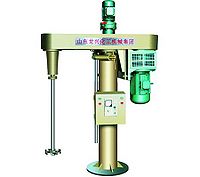Dispersion Machines
Dispersion Machines are used for liquid/liquid, solid/liquid, and liquid/gaseous have gained wide use in biodiesel laboratories and manufacturing plants. It is of broad interest to the emerging fuel industries and specifically to the manufacturers and processors of fatty acid methyl esters to utilize an economical, versatile and efficient dispersion methodology. On the laboratory scale, dispersion and formulation challenges in crude oil/fat refining such as acid or enzymatic degumming, neutralization, acid esterification, base transesterification, and even finishing processes such as dry or water wash processes, can be solved with small in-line or batch high-shear mixers.
Working Principles
The serrated circular blade of the dispersion plate rotates at a high speed so that materials flip up and down intensly in the container, and are impacted and sheared by the blade . As a result, the aggregate is destroyed to rapid dispersion, homogeneous mixing,and fast dissolution.
The machine stirs,dissolves and disperses the liquid or liquid - solid materials at a high speed,to complete the process of solid-liquid dispersion, wetting, depolymerization, and stabilization.
The speed can be arbitrarily adjusted (electromagnetic speed control and frequency speed control), and the speed range is 80-1250 rev / min. The medium speed is used to stir and dissolve, and the high speed to disperse into homogenization.
The main motor is the speed control motor.
Applications
It is widely used to produce coatings, dyes, ink, pigments, papermaking, cosmetics, food, resin, adhesive, lotion, medicine, oil, pesticides, daily chemical and other fields.
Video
